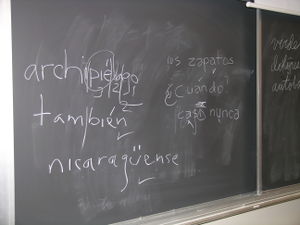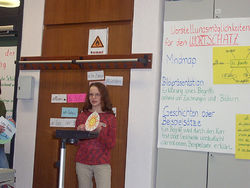Second language
A second language (L2) is any language learned after the first language or mother tongue (L1). Some languages, often called auxiliary languages, are used primarily as second languages or lingua francas.
A person's first language may not be their dominant language, the one they use most or are most comfortable with. For example, the Canadian census defines first language for its purposes as "the first language learned in childhood and still spoken", recognizing that for some, the earliest language may be lost, a process known as language attrition. This can happen when young children move, with or without their family (because of immigration or international adoption), to a new language environment.
Contents |
Age
According to some researchers, the defining difference between a first language (L1) and a second language (L2) is the age the person learned the language. For example, linguist Eric Lenneberg used second language to mean a language consciously acquired or used by its speaker after puberty. In most cases, people never achieve the same level of fluency and comprehension in their second languages as in their first language. These views are closely associated with the Critical Period Hypothesis.
In acquiring an L2, Hyltenstam (1992) found that around the age of six or seven seemed to be a cut-off point for bilinguals to achieve native-like proficiency. After that age, L2 learners could get near-native-like-ness but their language would, while consisting of few actual errors, have enough errors to set them apart from the L1 group. The inability of some subjects to achieve native-like proficiency must be seen in relation to the age of onset (AO). “The age of 6 or 8 does seem to be an important period in distinguishing between near-native and native-like ultimate attainment... More specifically, it may be suggested that AO interacts with frequency and intensity of language use” (Hyltenstam, 1992, p. 364).
Later, Hyltenstam & Abrahamsson (2003) modified their age cut-offs to argue that after childhood, in general, it becomes more and more difficult to acquire native-like-ness, but that there is no cut-off point in particular. Furthermore, they discuss a number of cases where a native-like L2 was acquired during adulthood.
As we are learning more and more about the brain, there is a hypothesis that when a child is going through puberty, that is the time that accents start. Before a child goes through puberty, the chemical processes in the brain are more geared towards language and social communication. Whereas after puberty, the ability for learning a language without an accent has been rerouted to function in another area of the brain—most likely in the frontal lobe area promoting cognitive functions, or in the neural system of hormone allocated for reproduction and sexual organ gowth.
Similarities and differences between L2 and L1
Speed
Acquiring a second language can be a lifelong learning process for many. Despite persistent efforts, most learners of a second language will never become fully native-like in it, although with practice considerable fluency can be achieved. However, children by around the age of 5 have more or less mastered their first language, with the exception of vocabulary and a few grammatical structures.
Stages
Acquiring a second language occurs in systematic stages. Much evidence has been gathered to show that basic sounds, vocabulary, negating phrases, forming questions, using relative clauses, and so on are developed. This development is independent of input (we do not hear nor read language in this order) and learning situation (in the classroom or on the street). It is also generally applicable across a spectrum of learners (from different language backgrounds). This is similar to the learning stages that babies go through when acquiring the first language: babbling (bababa), vocabulary (milk then later milk drink), negation (no play), question forming (where she go), and so on.
Correction
Error correction does not seem to have a direct influence on learning a second language. Instruction may affect the rate of learning, but the stages remain the same. Adolescents and adults who know the rule are faster than those who do not. In the first language, children do not respond to systematic correction. Furthermore, children who have limited input still acquire the first language.
Depth of knowledge
Learners in the first or second language have knowledge that goes beyond the input they received, in other words, the whole is greater than the parts. Learners of a language are able to construct correct utterances (e.g. phrases, sentences, and questions) that they have never seen or heard before.
Success
Success in language learning can be measured in two ways: likelihood and quality. First language learners will be successful in both measurements. It is inevitable that all first language learners will learn a first language and with few exceptions, they will be fully successful. For second language learners, success is not guaranteed. For one, learners may become fossilized or stuck as it were with ungrammatical items. (Fossilization occurs when language errors become a permanent feature. See Canale & Swain (1980), Johnson (1992), Selinker (1972), and Selinker and Lamendella (1978)). The difference between learners may be significant. Finally, as noted elsewhere, L2 learners rarely achieve complete native-like control of the second language.
| X | L2 | L1 |
|---|---|---|
| speed | NA | acquisition is rapid |
| stages | systematic stages of development | systematic stages of development |
| error correction | not directly influential | not involved |
| depth of knowledge | beyond the level of input | beyond the level of input |
| success (1) | not inevitable (possible fossilization*) | inevitable |
| success (2) | rarely fully successful | successful |
Theories of second language acquisition (SLA)

The distinction between acquiring and learning was made by Stephen Krashen (1982) as part of his Monitor Theory. According to Krashen, the acquisition of a language is a natural process; whereas learning a language is a conscious one. In the former, the student needs to partake in natural communicative situations. In the latter, error correction is present, as is the study of grammatical rules isolated from natural language. Not all educators in second language agree to this distinction; however, the study of how a second language is learned/acquired is referred to as Second Language Acquisition or SLA.
Research in SLA focuses on the developing knowledge and use of a language by children and adults who already know at least one other language... [and] a knowledge of second language acquisition may help educational policy makers set more realistic goals for programmes for both foreign language courses and the learning of the majority language by minority language children and adults (Spada & Lightbown, p. 115).
SLA has been influenced by both linguistic and psychological theories. One of the dominant linguistic theories hypothesizes that a device or module of sorts in the brain contains innate knowledge. Many psychological theories, on the other hand, hypothesize that cognitive mechanisms, responsible for much of human learning, process language.
Foreign language
In pedagogy, a distinction is often made between 'second language' and foreign language, the latter being learned for use in an area where that language is not generally spoken. Arguably, English in countries such as India, Pakistan, Bangladesh, the Scandinavian countries and the Netherlands can be considered a second language for many of its speakers, because they learn it young, speak it fluently, and use it regularly, indeed in southern Asia it is the official language of the courts, government and business.
The same can be said for French in the Arab Maghreb Union, except for Libya, although—like for English in the Scandinavian countries and the Netherlands—French is not an official language in any of these Arabic-speaking countries. In the post-Soviet states states such as Uzbekistan, Kyrgyzstan and Kazakhstan, Russian can be considered a second language, and there are large Russophone communities there.
In China (with the exception perhaps of Hong Kong), however, English would be considered a foreign language due to the lack of a number of characteristics, such as historical links, media, opportunities for use, similar vocabulary, and common script.
French would be considered a foreign language in Romania, Lebanon and Moldova as well. This is despite Romanian and French being romance languages (unlike Chinese and English, which come from two different language families). This is also despite Romania and Moldova being the only two countries in the world where Romanian is an official language at the federal level, Romania's historical links to France, and both Roumanophone countries' membership in the Francophonie. For Lebanon, French would be considered a foreign language, even though most of its universities operate in either that language or English, French is an administrative language and—like Romania—Lebanon has historical ties to France and is a Francophonie member state.
George Weber made a report in December 1999 about the number of secondary speakers of the world's leading languages.[1]
| 1. French (190 million) |
| 2. English (150 million) |
| 3. Russian (125 million) |
| 4. Portuguese (28 million) |
| 5. Arabic (21 million) |
| 6. Spanish (20 million) |
| 7. Chinese (20 million) |
| 8. German (9 million) |
| 9. Japanese (8 million) |
References
- ↑ The World's Most Widely Spoken Languages (reference for entire table)
